Railways Exam > Railways Questions > There are six students, P, Q, R, S, T and U w...
Start Learning for Free
There are six students, P, Q, R, S, T and U who have a different number of pens - 2, 4, 5, 7, 9 and 12 (not necessarily in the same order). The number of pens Q has is a prime number. U has 2 more pens than Q. The number of pens R has is a multiple of 4 but not a multiple of 3. P has fewer pens than Q but has more pens than S. Who has the highest number of pens?
- a)P
- b)Q
- c)S
- d)T
Correct answer is option 'D'. Can you explain this answer?
| FREE This question is part of | Download PDF Attempt this Test |
Verified Answer
There are six students, P, Q, R, S, T and U who have a different numbe...
Students: P, Q, R, S, T and U.
No. of pens: 2, 4, 5, 7, 9 and 12 (not necessarily in the same order).
1) The number of pens Q has is a prime number.
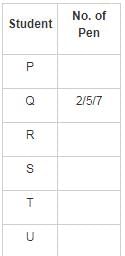
2) U has 2 more pens than Q.
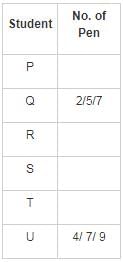

2) U has 2 more pens than Q.

3) The number of pens R has is a multiple of 4 but not a multiple of 3.
(So, R has 4 pens only.)
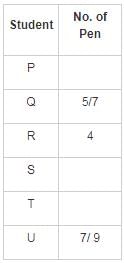

4) P has fewer pens than Q but has more pens than S.
(P cannot have 2 pens as S has fewer pens than P.
So, P has 5 pens and S has 2 pens.)
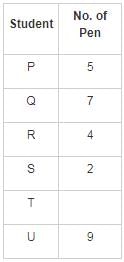

(So, T has 12 pens.)
Final arrangement:
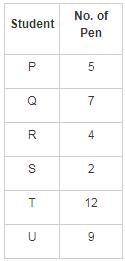
Hence, T has the highest number of pens.

Hence, T has the highest number of pens.
Most Upvoted Answer
There are six students, P, Q, R, S, T and U who have a different numbe...
Analysis:
Given Information:
- Q has a prime number of pens.
- U has 2 more pens than Q.
- R has a multiple of 4 but not a multiple of 3.
- P has fewer pens than Q but more pens than S.
Solution:
- Let's analyze the information given:
1. Since Q has a prime number of pens, the possible values for Q are 2 or 5.
2. As U has 2 more pens than Q, U can have either 4 pens (if Q has 2 pens) or 7 pens (if Q has 5 pens).
3. The number of pens R has is a multiple of 4 but not a multiple of 3. Based on this, R can have 4 pens, 8 pens, or 12 pens.
4. Since P has fewer pens than Q but more pens than S, the possible values for P are 2 or 4, and for S are 2 or 5.
- Now, let's determine the number of pens each student has based on the given conditions:
1. Q has a prime number of pens, so Q = 5.
2. U has 2 more pens than Q, so U = 7.
3. R has a multiple of 4 but not a multiple of 3, so R = 4.
4. P has fewer pens than Q but more pens than S, so P = 4 and S = 2.
5. The remaining number of pens goes to T, so T = 9.
- Therefore, the student with the highest number of pens is T with 9 pens.
Hence, the correct answer is option D) T.
Given Information:
- Q has a prime number of pens.
- U has 2 more pens than Q.
- R has a multiple of 4 but not a multiple of 3.
- P has fewer pens than Q but more pens than S.
Solution:
- Let's analyze the information given:
1. Since Q has a prime number of pens, the possible values for Q are 2 or 5.
2. As U has 2 more pens than Q, U can have either 4 pens (if Q has 2 pens) or 7 pens (if Q has 5 pens).
3. The number of pens R has is a multiple of 4 but not a multiple of 3. Based on this, R can have 4 pens, 8 pens, or 12 pens.
4. Since P has fewer pens than Q but more pens than S, the possible values for P are 2 or 4, and for S are 2 or 5.
- Now, let's determine the number of pens each student has based on the given conditions:
1. Q has a prime number of pens, so Q = 5.
2. U has 2 more pens than Q, so U = 7.
3. R has a multiple of 4 but not a multiple of 3, so R = 4.
4. P has fewer pens than Q but more pens than S, so P = 4 and S = 2.
5. The remaining number of pens goes to T, so T = 9.
- Therefore, the student with the highest number of pens is T with 9 pens.
Hence, the correct answer is option D) T.
Free Test
FREE
| Start Free Test |
Community Answer
There are six students, P, Q, R, S, T and U who have a different numbe...
Analysis:
Given Information:
- Q has a prime number of pens.
- U has 2 more pens than Q.
- The number of pens R has is a multiple of 4 but not a multiple of 3.
- P has fewer pens than Q but has more pens than S.
Solution:
Step 1: Determining the number of pens each student has based on the given information:
- Since Q has a prime number of pens, the options are 2, 5, or 7.
- U has 2 more pens than Q, so U can have 7, 9, or 12 pens.
- The number of pens R has is a multiple of 4 but not a multiple of 3, so R can have 4 or 12 pens.
- P has fewer pens than Q but more pens than S, so P can have 2, 5, or 7 pens.
Step 2: Analyzing the options:
- P can have 2, 5, or 7 pens.
- Q can have 5 or 7 pens.
- R can have 4 or 12 pens.
- S can have 2 or 4 pens.
- T has 9 pens.
- U can have 7, 9, or 12 pens.
Step 3: Comparing the number of pens each student has:
- P can have a maximum of 7 pens.
- Q can have a maximum of 7 pens.
- R can have a maximum of 12 pens.
- S can have a maximum of 4 pens.
- T has 9 pens.
- U has the highest number of pens, which is 12.
Therefore, based on the given information and analysis, student U has the highest number of pens, which is 12.
Given Information:
- Q has a prime number of pens.
- U has 2 more pens than Q.
- The number of pens R has is a multiple of 4 but not a multiple of 3.
- P has fewer pens than Q but has more pens than S.
Solution:
Step 1: Determining the number of pens each student has based on the given information:
- Since Q has a prime number of pens, the options are 2, 5, or 7.
- U has 2 more pens than Q, so U can have 7, 9, or 12 pens.
- The number of pens R has is a multiple of 4 but not a multiple of 3, so R can have 4 or 12 pens.
- P has fewer pens than Q but more pens than S, so P can have 2, 5, or 7 pens.
Step 2: Analyzing the options:
- P can have 2, 5, or 7 pens.
- Q can have 5 or 7 pens.
- R can have 4 or 12 pens.
- S can have 2 or 4 pens.
- T has 9 pens.
- U can have 7, 9, or 12 pens.
Step 3: Comparing the number of pens each student has:
- P can have a maximum of 7 pens.
- Q can have a maximum of 7 pens.
- R can have a maximum of 12 pens.
- S can have a maximum of 4 pens.
- T has 9 pens.
- U has the highest number of pens, which is 12.
Therefore, based on the given information and analysis, student U has the highest number of pens, which is 12.
Attention Railways Students!
To make sure you are not studying endlessly, EduRev has designed Railways study material, with Structured Courses, Videos, & Test Series. Plus get personalized analysis, doubt solving and improvement plans to achieve a great score in Railways.

|
Explore Courses for Railways exam
|

|
Similar Railways Doubts
There are six students, P, Q, R, S, T and U who have a different number of pens - 2, 4, 5, 7, 9 and 12 (not necessarily in the same order). The number of pens Q has isa prime number. U has 2 more pens than Q. The number of pens R has is a multiple of 4 but not a multiple of 3. P has fewer pens than Q but has more pens than S. Who has the highest number of pens?a)Pb)Qc)Sd)TCorrect answer is option 'D'. Can you explain this answer?
Question Description
There are six students, P, Q, R, S, T and U who have a different number of pens - 2, 4, 5, 7, 9 and 12 (not necessarily in the same order). The number of pens Q has isa prime number. U has 2 more pens than Q. The number of pens R has is a multiple of 4 but not a multiple of 3. P has fewer pens than Q but has more pens than S. Who has the highest number of pens?a)Pb)Qc)Sd)TCorrect answer is option 'D'. Can you explain this answer? for Railways 2024 is part of Railways preparation. The Question and answers have been prepared according to the Railways exam syllabus. Information about There are six students, P, Q, R, S, T and U who have a different number of pens - 2, 4, 5, 7, 9 and 12 (not necessarily in the same order). The number of pens Q has isa prime number. U has 2 more pens than Q. The number of pens R has is a multiple of 4 but not a multiple of 3. P has fewer pens than Q but has more pens than S. Who has the highest number of pens?a)Pb)Qc)Sd)TCorrect answer is option 'D'. Can you explain this answer? covers all topics & solutions for Railways 2024 Exam. Find important definitions, questions, meanings, examples, exercises and tests below for There are six students, P, Q, R, S, T and U who have a different number of pens - 2, 4, 5, 7, 9 and 12 (not necessarily in the same order). The number of pens Q has isa prime number. U has 2 more pens than Q. The number of pens R has is a multiple of 4 but not a multiple of 3. P has fewer pens than Q but has more pens than S. Who has the highest number of pens?a)Pb)Qc)Sd)TCorrect answer is option 'D'. Can you explain this answer?.
There are six students, P, Q, R, S, T and U who have a different number of pens - 2, 4, 5, 7, 9 and 12 (not necessarily in the same order). The number of pens Q has isa prime number. U has 2 more pens than Q. The number of pens R has is a multiple of 4 but not a multiple of 3. P has fewer pens than Q but has more pens than S. Who has the highest number of pens?a)Pb)Qc)Sd)TCorrect answer is option 'D'. Can you explain this answer? for Railways 2024 is part of Railways preparation. The Question and answers have been prepared according to the Railways exam syllabus. Information about There are six students, P, Q, R, S, T and U who have a different number of pens - 2, 4, 5, 7, 9 and 12 (not necessarily in the same order). The number of pens Q has isa prime number. U has 2 more pens than Q. The number of pens R has is a multiple of 4 but not a multiple of 3. P has fewer pens than Q but has more pens than S. Who has the highest number of pens?a)Pb)Qc)Sd)TCorrect answer is option 'D'. Can you explain this answer? covers all topics & solutions for Railways 2024 Exam. Find important definitions, questions, meanings, examples, exercises and tests below for There are six students, P, Q, R, S, T and U who have a different number of pens - 2, 4, 5, 7, 9 and 12 (not necessarily in the same order). The number of pens Q has isa prime number. U has 2 more pens than Q. The number of pens R has is a multiple of 4 but not a multiple of 3. P has fewer pens than Q but has more pens than S. Who has the highest number of pens?a)Pb)Qc)Sd)TCorrect answer is option 'D'. Can you explain this answer?.
Solutions for There are six students, P, Q, R, S, T and U who have a different number of pens - 2, 4, 5, 7, 9 and 12 (not necessarily in the same order). The number of pens Q has isa prime number. U has 2 more pens than Q. The number of pens R has is a multiple of 4 but not a multiple of 3. P has fewer pens than Q but has more pens than S. Who has the highest number of pens?a)Pb)Qc)Sd)TCorrect answer is option 'D'. Can you explain this answer? in English & in Hindi are available as part of our courses for Railways.
Download more important topics, notes, lectures and mock test series for Railways Exam by signing up for free.
Here you can find the meaning of There are six students, P, Q, R, S, T and U who have a different number of pens - 2, 4, 5, 7, 9 and 12 (not necessarily in the same order). The number of pens Q has isa prime number. U has 2 more pens than Q. The number of pens R has is a multiple of 4 but not a multiple of 3. P has fewer pens than Q but has more pens than S. Who has the highest number of pens?a)Pb)Qc)Sd)TCorrect answer is option 'D'. Can you explain this answer? defined & explained in the simplest way possible. Besides giving the explanation of
There are six students, P, Q, R, S, T and U who have a different number of pens - 2, 4, 5, 7, 9 and 12 (not necessarily in the same order). The number of pens Q has isa prime number. U has 2 more pens than Q. The number of pens R has is a multiple of 4 but not a multiple of 3. P has fewer pens than Q but has more pens than S. Who has the highest number of pens?a)Pb)Qc)Sd)TCorrect answer is option 'D'. Can you explain this answer?, a detailed solution for There are six students, P, Q, R, S, T and U who have a different number of pens - 2, 4, 5, 7, 9 and 12 (not necessarily in the same order). The number of pens Q has isa prime number. U has 2 more pens than Q. The number of pens R has is a multiple of 4 but not a multiple of 3. P has fewer pens than Q but has more pens than S. Who has the highest number of pens?a)Pb)Qc)Sd)TCorrect answer is option 'D'. Can you explain this answer? has been provided alongside types of There are six students, P, Q, R, S, T and U who have a different number of pens - 2, 4, 5, 7, 9 and 12 (not necessarily in the same order). The number of pens Q has isa prime number. U has 2 more pens than Q. The number of pens R has is a multiple of 4 but not a multiple of 3. P has fewer pens than Q but has more pens than S. Who has the highest number of pens?a)Pb)Qc)Sd)TCorrect answer is option 'D'. Can you explain this answer? theory, EduRev gives you an
ample number of questions to practice There are six students, P, Q, R, S, T and U who have a different number of pens - 2, 4, 5, 7, 9 and 12 (not necessarily in the same order). The number of pens Q has isa prime number. U has 2 more pens than Q. The number of pens R has is a multiple of 4 but not a multiple of 3. P has fewer pens than Q but has more pens than S. Who has the highest number of pens?a)Pb)Qc)Sd)TCorrect answer is option 'D'. Can you explain this answer? tests, examples and also practice Railways tests.

|
Explore Courses for Railways exam
|

|
Suggested Free Tests
Signup for Free!
Signup to see your scores go up within 7 days! Learn & Practice with 1000+ FREE Notes, Videos & Tests.
























